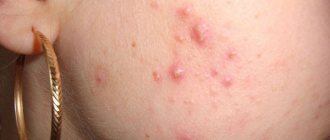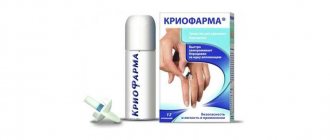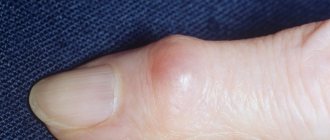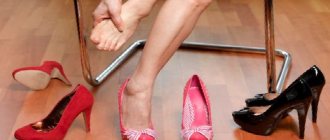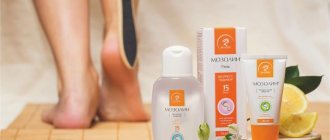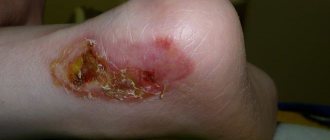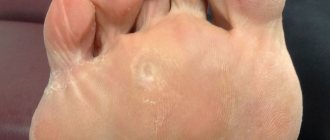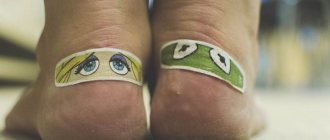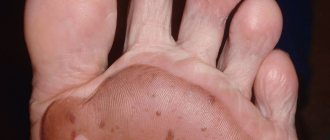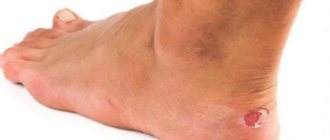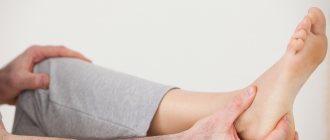Core (deep, ingrown) callus is the result of mechanical irritation of the skin. The formation is a keratinized growth with a dense structure that appears on the feet, toes, and sometimes on the palms. This type of neoplasm is practically no different from ordinary calluses, but when walking it causes a lot of inconvenience. A rod that has grown into the tissue often causes quite severe pain.
Why does a callus form?
The main reasons for the formation of ingrown calluses on the heel are due to prolonged mechanical irritation and pressure on the skin. Often the formation is associated with wearing new shoes with an uncomfortable last or the wrong size for the foot. Often the reasons for the appearance of ingrown calluses on the feet of women are an addiction to high heels. If high shoes are worn for a long time, the center of gravity shifts, the load on the front part increases, and a hard callus with a core is formed, which hurts and causes discomfort.
If the callus on the heel is weeping, it is usually not difficult to deal with the problem. With a dry, hard callus that has “grown” a shaft, you will have to fight quite a bit. Calluses usually become a source of great trouble, the reasons lie in the ongoing impact of a traumatic factor.
A rough core callus on the heel can form in the place where a weeping callus was previously located. Similar formations appear on the hands after prolonged physical work with unprotected hands. In some cases, the appearance of calluses is due to imbalances in the body.
- Callus can grow on any part of the body that is subject to prolonged mechanical pressure and irritation.
- It is possible to develop a callus when a small foreign body gets into the skin on the heel and subsequent long-term trauma. Presumably a small splinter, splinter or grain of sand. Prolonged exposure to the skin leads to increased synthesis of keratin by epidermal cells.
- Callus can be caused by metabolic disorders in the body or a viral infection.
What is a callus?
A callus is a thickening on any part of the human body. It is caused by the regular process of friction of the skin with any object. It often appears on the feet due to improperly selected shoes, hosiery, or due to the special structure of one or both feet.
Callus has two main types.
Depending on the structure, it can be skin or bone.
- The first type is the most common and appears to be a thickened part of the skin. The reason for the appearance is the body’s reaction to close contact with the surface of something.
- Callus differs in its structure. It can appear after a fracture in the form of a new growth from bone tissue.
Professional callus removal
Getting a problem known as an ingrown callus happens quickly, but removing the formation is much more difficult. Many professional methods of combating calluses, medications and traditional medicine recipes have been developed.
Professional callus removal methods are quick and convenient. They practice in specialized medical and cosmetology clinics.
- Drilling is carried out in beauty salons, where pedicure services are provided. The master has special equipment. A cutter suitable in size is selected. The core of the callus on the feet is carefully drilled out, taking care not to damage the surrounding healthy skin. It is important that the drilling removes all of the stem tissue. If a couple of tiny particles remain inside the skin, the callus will quickly grow back and will be much more difficult to get rid of again. When drilling is completed, the cavity is filled with salicylic acid.
- Laser surgical treatment is used in severe cases. The laser scalpel acts on the core of the callus, allowing you to get rid of the root without affecting the surrounding healthy tissue. At the same time, the laser beam destroys the viral and fungal infection that sometimes accompanies the callus. The advantage of the described method of radical removal is the possibility of precise dosing of the effect. The laser surgery method is bloodless, low-painful, and leaves no scars.
Do not try to do home treatment and cut out the callus with a razor blade. Firstly, it is easy to cut yourself and get an infection; subsequent treatment will be carried out by doctors in the surgical department. Secondly, with the help of a blade it will not be possible to remove the entire shaft; soon the callus will grow again.
Which doctor should I contact for help?
- The main specialist is a dermatologist. However, depending on the nature of the disease, there may be other options.
- In the case of callus, you should seek help from a surgeon. It will also help with purulent, infected and severe calluses.
- In other situations, aesthetic medicine specialists can come to the rescue. Using cryotherapy, laser or hardware drilling, the defect can be removed.
In particularly advanced situations, the intervention of a surgeon and an operation may be required, which will affect the entire life activity of a person and limit the usual physical activity. In addition to laser and surgery, conventional ointments can be used in treatment. But often a person notices the presence of a problem already in an advanced state, which requires a serious approach to recovery.
To effectively combat calluses, their prevention is necessary. In areas most susceptible to mechanical stress, it is worth applying cream in the evenings or gluing a patch when wearing uncomfortable shoes. Socks and shoes on your feet must match in size and be made from natural fabrics and materials.
source
Medications
Today's pharmacological industry offers a wide range of products for local treatment of ingrown calluses on the feet and to get rid of the callus. This includes special gels, creams, solutions and patches.
Keratolytic agents. Creams or liquids that often contain salicylic acid. The substance has a pronounced keratolytic effect and is good for getting rid of excess stratum corneum of the epithelium on the legs. However, it is recommended to treat calluses with such means with caution. The effect often extends to healthy areas of the skin, causing irritation and the formation of ulcers.
Pharmaceutical agents in the fight against calluses on the toes
Products in this category are sold in any pharmacies. The most commonly used are ointments or adhesive plasters. It is important that both have a softening effect and a healing one - this helps speed up the process of callus removal.
The technology for using both products is very similar: you should apply an adhesive plaster to the problem area of the skin or lubricate it with ointment, then fix it and wear it for 2 days. Just like with traditional medicine, several sessions may be required.
The most popular ointments:
The most popular adhesive plasters:
Traditional recipes for removing ingrown calluses
If the patient, for some unknown reason, is not satisfied with pharmaceutical drugs, there is no opportunity to visit a specialized clinic and carry out radical treatment, it is possible to treat the callus using recipes from traditional healers.
If an ingrown dry callus reveals that the stem is not too long, they resort to a simple and accessible method using soda-soap baths. Preparing a bath is not difficult. Pour hot water into a basin or bucket, adding soda and rubbing in a little laundry soap. You will need to steam your feet in the bath for half an hour. After the procedure, it is not always necessary to remove roughened areas of the horny epithelium on the toes or heel using an abrasive. If the core of the callus on the little finger is short, the callus often falls off on its own after 5 to 10 procedures.
Instead of soap and soda, it is permissible to add mustard powder to hot water. The rest of the technique is completely similar to that described above.
It is allowed to remove the callus on the foot using vinegar essence. It is first recommended to protect healthy skin with a patch. A drop of essence is dripped onto the top of the callus on your foot. Several procedures will be required to completely remove the callus.
Celandine juice has long been known and tested as a folk remedy. The juice is most often used in the treatment of warts, but the effect in the treatment of calluses is no worse. Apply in the same way as acetic acid, protecting healthy skin around it. It can be applied using a cotton pad or patch.
It is possible to remove a foot callus that is not too deeply ingrown using a paste of garlic or onion. The mixture is applied to the callus and secured on top with a bandage or plaster. It is recommended to first thoroughly steam the corn in hot water and soda. After 15 to 20 treatment sessions, the dry callus will fall off on its own along with the long inner core.
How to prevent calluses
Preventing calluses is much easier than removing them later. Prevention does not require tricks or effort. The rules are simple:
- Be sure to observe personal hygiene requirements and keep your feet clean. The inside of your shoes, socks or stockings should be clean.
- Avoid wearing tight, uncomfortable shoes. You should not wear high-heeled shoes for too long, changing your shoes periodically.
- Use softening foot creams and anti-excessive sweating products.
- If a blister or chafing appears on the leg, immediate treatment is indicated.
When starting heavy work, make sure to protect your hands with mittens or gloves.
Surgeon, coloproctologist, phlebologist. Area of professional interests: treatment of surgical and trauma patients, including minor outpatient operations (removal of skin and subcutaneous tissue tumors) using surgical, radio wave and laser methods in dermatology (removal of atheromas, lipomas, nevi, papillomas, warts). Minor proctology in full (laser hemorrhoidectomy, hemorrhoidectomy with the Surgitron radio wave apparatus).
Core (ingrowing, deep) callus is a dense keratinized growth on the sole, toes, and less often on the palms. At first glance, the formation is practically no different from ordinary calluses. But the rod variety with a black dot in the central part of the formation causes much more inconvenience.
In the area of the compacted, hardened growth, severe pain is felt when walking. Calluses on the toes get in the way, rub, and prevent you from wearing fashionable shoes. The sooner you recognize an insidious formation and consult a doctor, the greater the chances of recovery.
Types of calluses and treatment methods
Gvozdevaya
A rare type of callus.
Does not have a hole or black spot in the middle.
Outwardly it resembles a nail, the head of which is on top.
It has a small round shape.
Rod
A distinctive feature of this callus is its structure.
The surface of the skin acquires a slight compaction, and under it there is a base.
The main inconvenience is severe pain due to the root located in the tissues.
Such a deep callus can be removed by contacting a medical center for hardware or surgical intervention.
There are several ways to get rid of a callus, for example drilling.
Cryotherapy, as a result of which the callus is frozen, and it dies off on its own.
Laser action that evaporates the liquid contained in the callus, which leads to drying of the rod and the formation itself.
Water
A similar callus can be observed when wearing uncomfortable shoes.
A blister appears that is filled with blood or lymph fluid. The outer skin is thin and easily torn from external influences.
A watery callus should not be pierced or picked off on its own. The treatment procedure is aimed at eliminating mechanical effects at the site of injury.
As a result, the neoplasm will heal on its own, and the contained lymphatic fluid will dissolve and help restore the skin.
Dry
Occurs in various parts of the body. It is a small keratinized part of the skin. It feels hard and unpleasant to the touch.
Treatment should be carried out even in the absence of painful symptoms.
To do this, steam your feet in warm water with various additives such as soda, soap, potassium permanganate or tea tree oil.
Corns
This callus is similar to the one described above.
However, it only appears on the soles of the feet.
It has no definite boundary and varies in size.
The cause of the appearance is general dry skin, frequent walking and wearing hard shoes.
Cone
It appears as thickenings on the big toes. Sometimes it causes discomfort when walking.
The cause may be heredity.
Development occurs for no apparent reason.
Bumps also occur when wearing uncomfortable shoes for a long time.
If the callus is exposed to regular mechanical stress, it can turn into a bunion. This type of callus occurs on the big toes near the joints and contains fluid inside.
The result is severe pain when walking.
Treatment for a bump or bunion should begin by changing your shoes to more comfortable ones. If the callus does not cause pain and does not grow, then there is no reason to worry. But when it becomes a hindrance, you should visit a surgeon.
Outdated
Without timely action, the rubbed parts of the skin turn from new calluses into old ones, the skin on which is keratinized. Such formations are most uncomfortable on the toes. The treatment is long and difficult. Modern pharmacology provides many means to get rid of rough skin. Their action is based on softening and then removing the growth.
The most well-known method for removing calluses on the feet is cutting. To do this, you need the following: a bath with hot water, soap and soda.
- Keep your feet in it for 15 minutes.
- As a result, the old skin will become softer and the top layer can be removed.
- Then apply a patch or lubricate the area with salicylic acid.
The procedure is carried out carefully. The drug should be kept away from healthy skin to avoid damage.
Causes
Deep callus appears under the influence of various factors. Main reasons:
- constant mechanical impact (friction, pressure) on the skin. Tight, uncomfortable shoes, wrinkled, torn insoles, socks that don’t fit and rub and put pressure on the soles. The result is calluses on the toes;
- damage to the skin by a foreign body, for example, a grain of sand, a splinter. Inattention to a foreign object under the skin leads to its ingrowth into the stratum corneum. Gradually a growth forms around the foreign body, pain is felt in this area;
- walking barefoot for a long time. Often, deep calluses appear in residents of rural areas, children running barefoot during their summer holidays in the village;
- wearing shoes made of low-quality materials. The feet do not breathe, sweat, slip, and friction increases. A wrinkled insole increases the negative impact on the skin;
- Growths on the feet are caused by two factors that are radically different from each other - high heels and flat soles. In both the first and second cases, corns and calluses often form;
- Seals appear on the palms and fingers when constantly working with tools. If left untreated, an ordinary callus will degenerate into a dry variety. After a while, under the influence of a fungus, when the skin is injured, a rod grows deep into the tissue;
- fungal or viral infection. Growths caused by exposure to pathogenic flora are difficult to treat, especially in advanced cases with deep ingrowth of the core. Fungi often form calluses on the hands.
Medications
Pharmaceutical preparations based on salicylic acid will help get rid of painful growths. Apply the composition only to damaged areas: the potent product irritates healthy skin.
For the treatment of calluses on the feet, the following are effective:
- ointment "Super Antimozolin". Active components – urea, lactic acid;
- Vitaon or Karavaev balm. The drug contains herbal extracts and copes well even with deep formations;
- cream "Nemosol". A proven product containing salicylic acid;
- liquid "Stop callus". With regular use, good results are noticeable. Another advantage is convenient packaging;
- If fungi or viruses are detected, the dermatologist will prescribe modern antiviral and antifungal compounds - Acyclovir, Penciclovir, Lamisil.
Find out interesting details about ultrasonic facial cleansing at home.
Read all about treating psoriasis on the body with folk remedies on this page.
Callus with black dots on the finger and its treatment
A core or black callus is a compacted keratinized growth on the sole or toes, on the palms of the hands. Characteristically different from ordinary calluses with a black dot in the center, the formation causes a lot of inconvenience.
The callus rubs when walking, causing pain. The growth should be treated as early as possible, using both medicinal, surgical and traditional methods of disposal. Let's look at the causes and treatment of the growth.
How to treat ingrown calluses?
The main thing you should know is no self-medication! Such formations are strictly not allowed to be cauterized, cut out, steamed, or treated with caustic compounds or “magic” ointments.
All methods not recommended by the doctor often lead to skin damage, which will lead to the dynamic growth of deep calluses. First a dermatologist, then treatment. Only a doctor can determine the dynamics of the course and development of the pathology, the depth of germination of the rod.
Depending on these factors, treatment will be determined and medicinal, surgical or traditional methods of treatment will be prescribed.
Important! A viral fungal infection, which is typical in the presence of a black callus with a dot, can quickly spread to healthy areas of the skin if self-medicated. Curing the disease will become much more difficult.
Medicines and drug therapy
A callus on the toe or sole can be treated with pharmaceutical preparations based on salicylic acid. The preparations are applied only to the affected area; it is prohibited to apply the preparations to healthy skin. The following medicinal formulations are best suited:
- Super Anticallos is a drug for removing growths, containing the active ingredients urea and lactic acid.
- Balm Karavaeva (Vitaon) with herbal extracts. The product is very effective and can be used to treat deep root germinations.
- Nemozol is a cream containing concentrated salicylic acid and has already proven effectiveness.
- Sto-corn is a liquid substance packaged in a bottle with a dispenser. Ease of use is a big plus, but the therapy will be long, but regular use provides very good results.
Advice! If the dermatologist determines the presence of a fungus or viral infection, antifungal drugs such as Acyclovir, Penciclovir, Lamisil will be prescribed.
The Salipod plaster is a good way to combat calluses. An effective remedy rarely fails to treat growths caused by a fungal or viral infection. Application of the patch is incredibly simple:
- Apply a patch to a dry and clean lesion;
- Secure Salipod with a regular plaster;
- Do not remove the bandage for 3-4 days, then remove the bandage;
- Steam the foot and remove the rod.
If the rod part has gone deep enough, you should repeat the procedure again with wearing a bandage for 3 days.
After removing the rod, a deep wound remains, which must be lubricated with an antiseptic and protected from dirt.
In addition to this type of patch, pharmacies offer quite a few other identical products and their use is the only cases when piercing the growth is allowed, and then only after preliminary steaming in hot water.
Advice! Orthotics should be worn during medication treatment to relieve pressure on the foot or heel.
Medicines are not the only option; in some cases, doctors prescribe more modern methods for removing ingrown calluses:
- Laser removal is effective in very advanced cases. The laser beam burns the core base and removes all pathogenic bacteria, minimizing the risk of inflammation after the procedure.
- Hardware drilling (removal) is the process of removing a deeply embedded rod. After the procedure with a special device, the doctor puts an antibacterial agent into the wound to prevent relapses and infection of the affected area.
- Cryodestruction with liquid nitrogen is a proven method of burning out a seal with a central rod. The efficiency and painlessness of the operation, as well as the absence of the risk of secondary germination, are the advantages of the procedure.
- The radio wave ablation method is a painless operation in which radio waves evaporate water from abnormal cells, destroying the formation. Pros: no impact on adjacent healthy tissue.
- Electrocoagulation – removal of growths by exposure to alternating current. A protective crust remains at the site of burning, which acts as a biological bandage. After 10-12 days, the crust disappears on its own, leaving clean skin.
All treatment methods are prescribed only after examination by a dermatologist.
It is strictly forbidden to use medications for self-medication due to the possibility of developing a fungal infection in the callus.
Even a safe patch can lead to the proliferation of bacteria and the rapid development of the disease. In this case, the lesion will increase in area and depth, but it will be much more difficult to cure it.
Corn plaster
The Salipod callus patch was created specifically to combat ingrown calluses An effective, easy-to-use remedy will relieve painful formations in a short time.
Of course, there are exceptions, sometimes the patch does not help. Most likely, a fungal or viral infection is to blame in this case. You can’t do without special creams and ointments.
- wash your feet, dry them;
- Apply “Salipod” to the affected skin and secure it with an adhesive plaster on top;
- keep the patch on the callus for 3 days;
- after the expiration date, remove “Salipod”;
- steam your feet, remove the rod;
- if the core is deeply ingrown, repeat the procedure;
- usually the rod comes out, leaving a hole;
- treat this area with iodine and cover it with an adhesive plaster.
Modern removal methods
Consult a dermatologist about removing growths on the soles of your feet and toes. There are effective, painless methods that allow you to get rid of even overgrown formations. A beauty salon or beauty clinic will offer you several effective methods.
Professional methods for removing callus:
- laser removal. The method is effective in advanced cases. The laser beam is capable of burning the rod to the ground. Another advantage is that during the procedure, pathogenic bacteria that have penetrated the affected area are destroyed. For this reason, the risk of developing an inflammatory process after the procedure is reduced to zero;
- hardware callus removal. The doctor uses a special device to “drill out” the formation. It is important to completely get rid of the rod. After the procedure, an antifungal or antibacterial agent is placed in the canal. A correctly performed procedure usually does not cause complications. The risk of relapse is minimal;
- cryodestruction. Removing growths using liquid nitrogen is one of the proven methods. Low temperatures “burn out” the painful lump along with the central part. Less than a minute - and the tissues are destroyed. With complete removal, re-germination is virtually impossible.
And a little about the author’s secrets
Have you ever experienced unbearable joint pain? And you know firsthand what it is:
- inability to move easily and comfortably;
- discomfort when going up and down stairs;
- unpleasant crunching, clicking not of your own accord;
- pain during or after exercise;
- inflammation in the joints and swelling;
- causeless and sometimes unbearable aching pain in the joints.
Now answer the question: are you satisfied with this? Can such pain be tolerated? How much money have you already wasted on ineffective treatment? That's right - it's time to end this! Do you agree? That is why we decided to publish an exclusive interview with Oleg Gazmanov, in which he revealed the secrets of getting rid of joint pain, arthritis and arthrosis.
calluses always cause discomfort and a desire to get rid of them as quickly as possible.
But often people resort to the wrong methods of getting rid of calluses.
But before treatment, you should understand its type and cause of its appearance.
In the article we will look at what a callus is, as well as their types.
In addition, we will tell you which doctor to contact for help and about methods of treating calluses.
Folk remedies and recipes
Many people prefer home remedies. With the help of medicinal plants and certain products, you can get rid of annoying formations on the feet, fingers, and palms.
Remember! It is not recommended to use traditional methods before consulting a dermatologist. Improper exposure can cause harm, especially if compactions and soreness appear under the influence of viruses or pathogenic fungi.
Proven recipes for treating and removing calluses on the feet at home:
- baths with mustard. Heat water, dilute mustard powder (1 tsp of dry product per liter of liquid). The duration of the procedure is half an hour;
- onion or garlic paste. Chop the onion and pass the garlic through a special device. Use the resulting mass to treat shallow calluses. Steam your legs well, apply the paste, and top with gauze and a fixing bandage. After 10–12 procedures, the growth should fall off along with the core;
- hot soap and soda baths. An excellent method for the early stages of build-up. Mix grated laundry soap and baking soda in equal parts, dissolve in hot water. After 30 minutes, wash your feet and apply pumice. After a week of regular procedures, the rod often comes out on its own;
- celandine juice. Suitable for combating shallow calluses. Steam your feet, dry them, and protect the healthy skin around the callus with an adhesive plaster on all sides. Drip celandine juice onto the top of the growth (caution, poisonous). After several sessions, the stratum corneum should come off.
How to treat furunculosis? We have the answer!
In this article, learn everything about the treatment of condylomas in men and women.
Core calluses in children
Dense painful growths often appear in children after summer holidays spent in the village with their grandmother. More often, boys suffer from unpleasant manifestations due to the specifics and nature of the games, less attention to appearance, the quality of shoes, and foot hygiene. Running barefoot on the grass or country road injures delicate skin.
Children often exchange sandals and shoes. A fungal infection penetrates the stratum corneum.
- tight, low-quality shoes that “do not breathe”;
- uncomfortable, sliding insoles;
- crumpled socks that are the wrong size;
- old wounds, splinters, around which a keratinized area has appeared;
- viral, fungal infections.
What to do? Be sure to consult a dermatologist. The doctor will check whether the child has corns or calluses. In the early stages, age-appropriate folk remedies will help. Often the doctor recommends ointments and callus fluids. The choice of product also depends on the age of the child.
For deep rods, the most gentle and effective procedure for children is laser destruction. The low-pain method is used in most cosmetology clinics.
- no pain;
- high-quality removal of formation and core;
- minimal recovery period;
- low probability of relapse.
Preventive recommendations
Preventing the appearance of deep calluses is simple:
- choose shoes made of genuine leather;
- change wrinkled or torn insoles in a timely manner;
- do not walk for a long time in shoes with thin soles or, conversely, high heels;
- take care of your feet, don’t forget about pumice and nourishing foot creams;
- for severe sweating, take baths with chamomile, oak bark, sprinkle your feet with talcum powder or baby powder;
- Don't wear other people's shoes.
Below is a video in which you can clearly see the process of removing calluses using a modern hardware method:
Did you like the article? Subscribe to site updates via RSS, or follow updates on VKontakte, Odnoklassniki, Facebook, Google Plus or Twitter.
Subscribe to updates by E-Mail:
Tell your friends!
Diagnostics
You need to decide how to treat a wet callus only after diagnosis. Doctors conduct an external examination. Additionally, palpation is required. Usually no additional examinations are required.
It is also important to establish the true cause of the violation. Sometimes the deviation is due to internal pathologies. First of all, the doctor will pay attention to the shoes the patient is wearing. If it's not about shoes, the doctor will find out about work activity and physical activity.
Of the instrumental techniques, an x-ray examination of the foot is necessary. This is necessary when the doctor suspects a foot deformity or a disease of the musculoskeletal system. When determining how to treat a water callus, you may need to consult a rheumatologist or orthopedist.
Important! A medical history is required. The doctor is looking for a connection between the callus and possible pathologies of metabolic processes.

